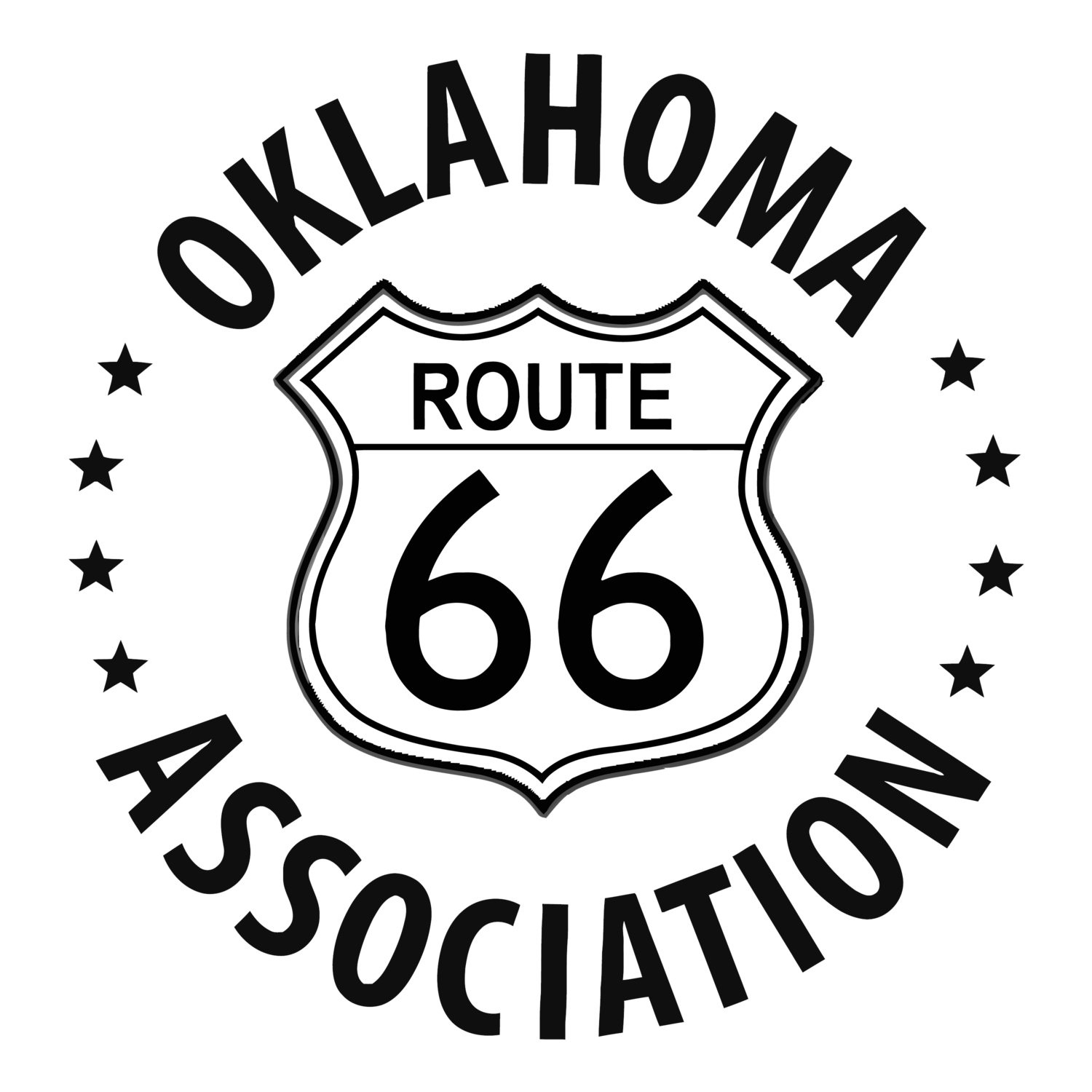The Will Rogers Highway
by Rhys Martin
Route 66 has many nicknames: The Mother Road, The Main Street of America…even “Route 66” is a nickname, really. US Highway 66 is its real name, or was when it was still an active federal road. It’s also known as the Will Rogers Highway, named after the most famous public figure of the early 20th century. Perhaps you’ve seen it on historic markers or old maps. But where did it get this nickname?
Classic Will Rogers Highway image courtesy of Joe Sonderman.
First, you have to know who Will Rogers was. It’s hard to compare him to any modern-day celebrity because his fame was wide-reaching across every available media platform, but here’s a quick summary. He was born of Cherokee lineage in Indian Territory, near modern-day Claremore, Oklahoma, in 1879. He grew up on a ranch and gained an affinity for roping. Will performed in rodeos and went international before breaking into show business. What started as trick roping in the circus and vaudeville grew into a film career, lecture tours, newspaper columns, radio broadcasts, and even political influence. By the 1930s, he was arguably the most famous person in the world.
In 1926, the same year that Will toured Europe as President Calvin Coolidge’s goodwill ambassador, US Highway 66 was established along with the rest of the numbered federal highways. Shortly thereafter, Cyrus Avery and others formed the US Highway 66 Association. It was a natural evolution of the organizations that had supported earlier named roads like the Jefferson Highway or the Ozark Trail. The goal of this Association was to promote the Chicago-to-Los Angeles thoroughfare as the “Best Way West,” which included a push to pave the entire length of the road.
Tulsa World newspaper story from August 18th, 1935.
On August 15th, 1935 Will Rogers died in plane crash. It was a national tragedy and many people wanted to pay tribute to Will’s memory, especially in his native Oklahoma. Only three days later, several Tulsa citizens started a campaign to urge Congress to rename Highway 66 as the Will Rogers Highway, noting that it connected Rogers’ hometown to Hollywood. It didn’t take long for people to come around to the idea, and on December 9th the US Highway 66 Association formally designated Highway 66 the Will Rogers Highway. Will Rogers, Jr. even sent a telegram to the Association at their annual meeting in Amarillo to bless the endeavor.
From the Claremore Progress, January 23rd, 1936.
In January of 1936, a new Will Rogers Highway logo was unveiled. The name and logo was highly publicized when the highway was fully paved in 1938. It was referenced as the Will Rogers Highway in newspapers across the country and a sign showed up on the silver screen in the famous 1939 film, The Grapes of Wrath. Even the US Highway 66 Association itself was referred to as the Will Rogers Memorial Highway Association.
Venice Mardi Gras Beauty Contest in August of 1938. Claire James, wearing the Miss Hollywood sash, was named Miss California a short time later and flew to Amarillo for the celebration of Route 66 being fully paved. Some of the others pictured here are Ann Walker (Miss Venice), Alyn Lockwood (Miss Santa Monica), Mitzi Uehlein (Miss Culver City), and Marjorie Wilson (Miss Crescent City).
World War II changed everything, of course, and the organization went dormant. The Association was reactivated in 1947 in large part by Jack and Gladys Cutberth of Clinton, Oklahoma. They traveled the road personally once or twice a year connecting with the people that lived and worked along the road, producing new maps and guides as they went. But Will wasn’t forgotten – far from it.
Variety advertisement about the Story of Will Rogers and the caravan down Route 66.
Warner Brothers had a new film coming out in 1952 called The Story of Will Rogers with Will Rogers, Jr. playing his father. To promote the new film, the film studio sponsored a caravan to drive Route 66. Ford brought several brand-new station wagons along for the journey and the US Highway 66 Association was more than happy to promote this long parade. It began at the Chain of Rocks Bridge at the Illinois/Missouri border on June 23rd and ended on July 1st in Santa Monica, California. One million windshield stickers were printed and special commemorative leaflets were handed out at the dozens of stops along the way. At each state border, a bronze marker was installed to re-dedicate Route 66 as the Will Rogers Highway.
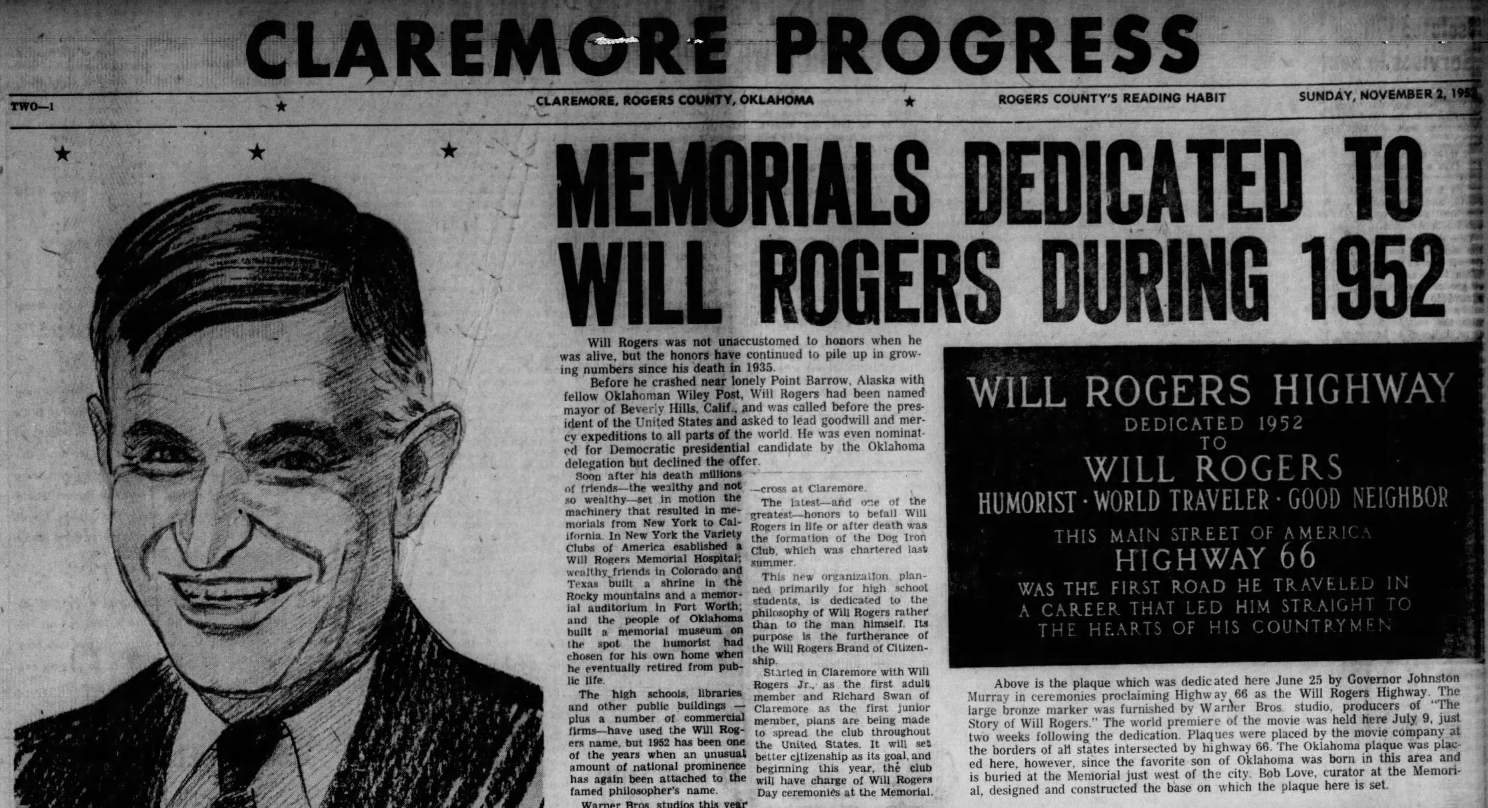


Fans of Route 66 know what came next: the Interstate Highway System. Construction on the new roadways began in the mid-1950s and, piece by piece, old Highway 66 was bypassed. The US Highway 66 Association ceased publishing its travel brochures in 1974 and it disbanded a few years later. Route 66 was formally decertified in 1985…but the story didn’t end there. Statewide associations were created to promote the historic road and let the world know it was still there and worth traveling. The Oklahoma Route 66 Association was formed in 1989.
One of the original bronze Will Rogers Highway markers, now installed in Palisades Park in Santa Monica, California.
By the time the Oklahoma Route 66 Association was founded in 1989, only a few of the original bronze Will Rogers Highway plaques survived; notably, at the Will Rogers Memorial Museum in Rogers’ hometown of Claremore and near the Santa Monica Pier in California. A third one is embedded in concrete at Pappy Litch Park in Galena, Kansas. In the 90s, Route 66 enthusiasts began an initiative to revive the road’s nickname with a series of markers, this time with something that would be much more difficult to remove.
Darrell Ray, Bob McSpadden, and Don Gray at the unveiling of the new Vinita marker in 1999. Bob and Don raised over $3,000 in a matter of minutes after going on the radio to announce the initial fundraising campaign for the marker.
Darrell Ray of Joplin came up with a design that utilized the classic Will Rogers Highway logo for a modern granite historical marker. This design was used to create a series of rose-colored stone historic markers along Route 66. The first one was unveiled in Vinita, Oklahoma on Thursday, October 14th, 1999 to great fanfare. Other communities were encouraged to sponsor their own Will Rogers Highway marker (check out this promotional video from the time!) Once the Oklahoma Route 66 Association learned of the project, we were happy to help raise funds and awareness.
Darrell Ray, Pat Smith, Don Rudolph, and Corky Heard at the Oklahoma Route 66 Museum marker dedication in 2001.
The second marker popped up in Claremore at the J.M. Davis Arms & Historical Museum the following year. A third monument was unveiled outside of the Route 66 Museum in Clinton. Several more were built over the next decade, including markers in Galena, Kansas and Joplin, Missouri. The latest marker was built in 2009 on the edge of Afton to mark a segment of the Sidewalk Highway. Below is a map of the ten markers that are installed as of 2025.
Perhaps the most well-known of these granite markers stands near the Texas and Oklahoma border in Texola, honoring the original 1952 bronze plaque that had once stood nearby.

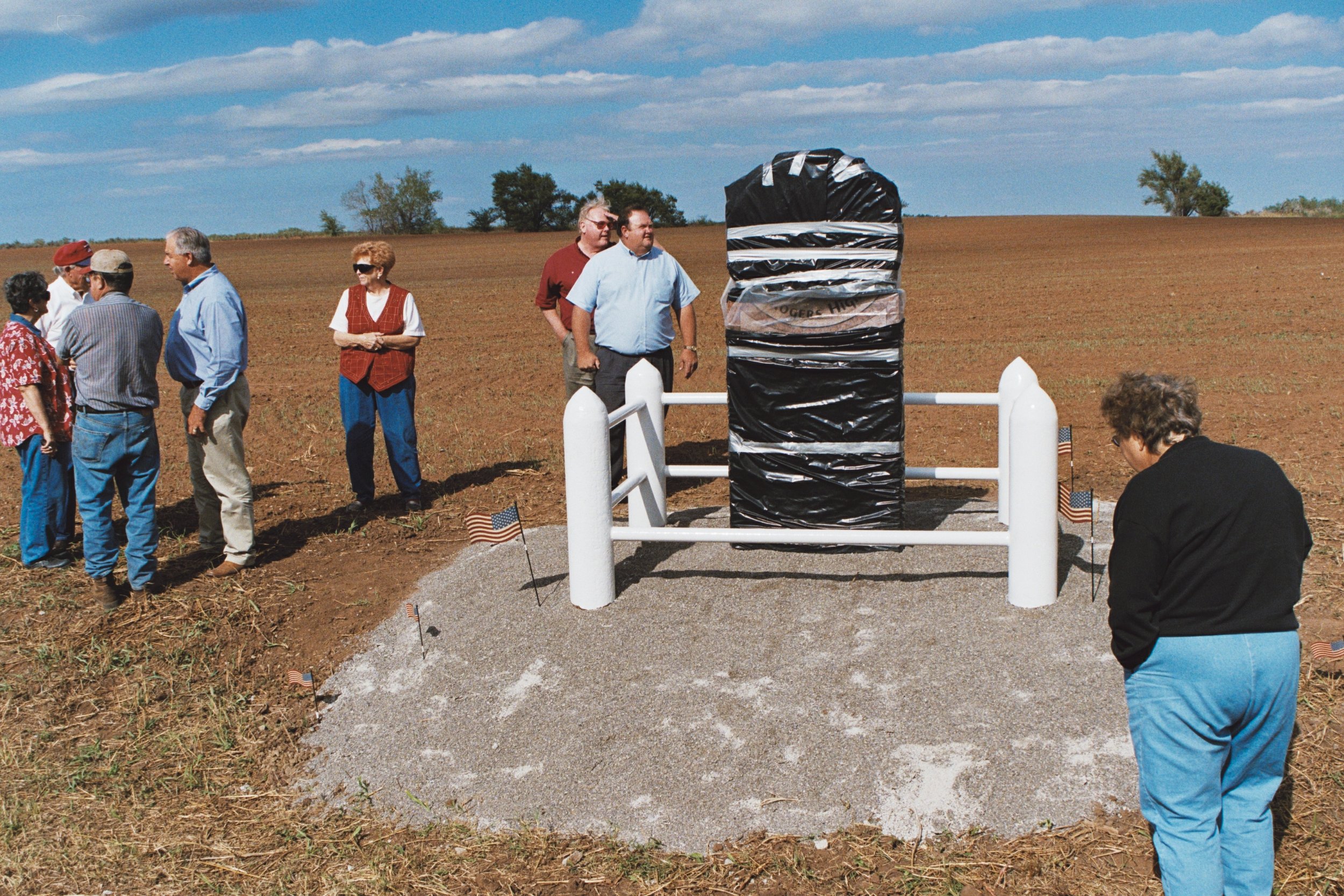
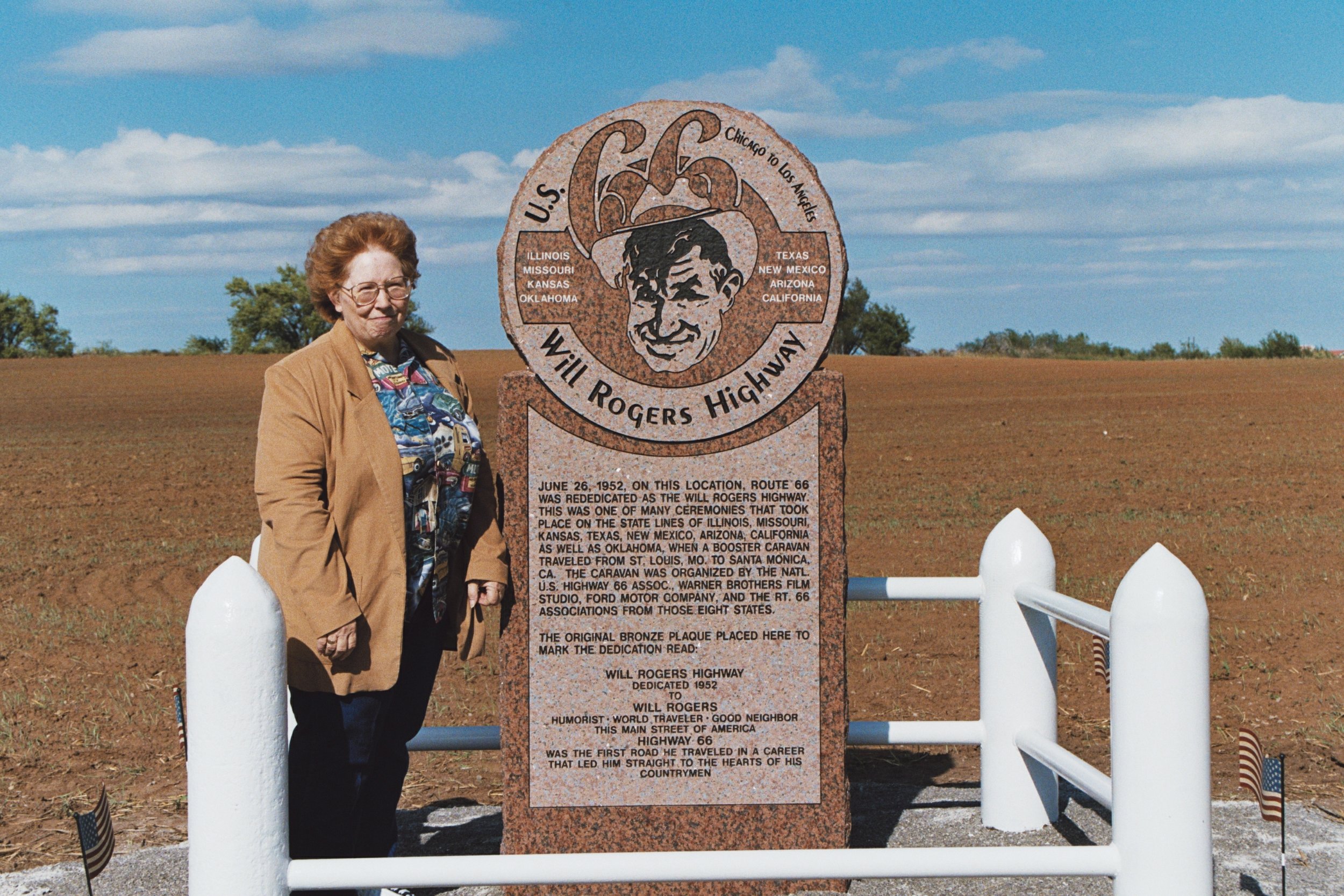
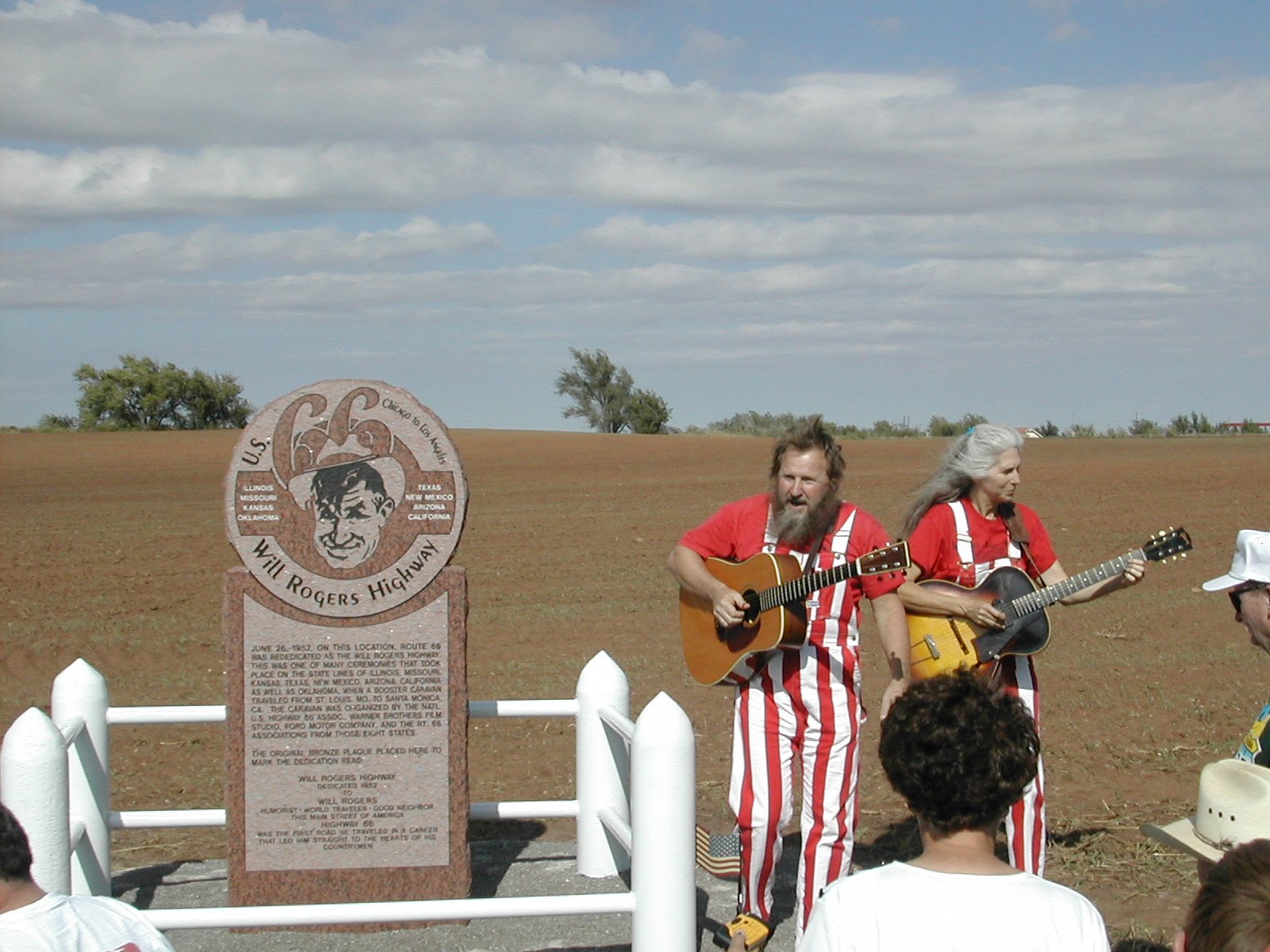
Spearheaded by Western Oklahoma advocate Carol Duncan, the Oklahoma Route 66 Association organized a cruise and celebration on October 5th, 2002 to mark the 50th anniversary year of that original caravan. The caravan of cruisers met at the Windmill Restaurant in Texola along with Senator Robert Kerr, Old Route 66 Association of Texas President Becky Ransom, and others to mark the occasion before heading to the border. The group was met by Harley and Annabelle Russell, the Mediocre Music Makers from Erick, who provided the entertainment. As luck would have it, a tour bus stopped as they were making their way back to California from a Route 66 Festival in Springfield, Illinois. Only on the Mother Road!
Although Route 66 goes by many names, we will always be partial to the road’s long association with Oklahoma’s Favorite Son. If you’d like to take Will with you on YOUR travels, check out our Flat Will Rogers!
The Will Rogers Highway marker in Texola, not far from the Texas border.
